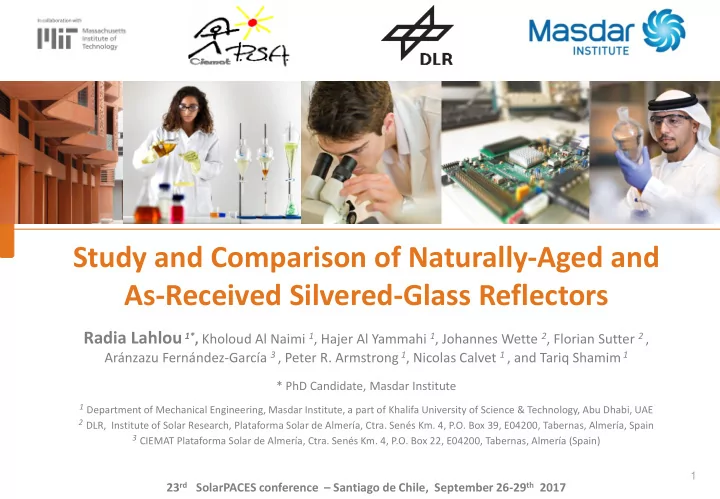

Study and Comparison of Naturally-Aged and As-Received Silvered-Glass Reflectors Radia Lahlou 1* , Kholoud Al Naimi 1 , Hajer Al Yammahi 1 , Johannes Wette 2 , Florian Sutter 2 , Aránzazu Fernández-García 3 , Peter R. Armstrong 1 , Nicolas Calvet 1 , and Tariq Shamim 1 * PhD Candidate, Masdar Institute 1 Department of Mechanical Engineering, Masdar Institute, a part of Khalifa University of Science & Technology, Abu Dhabi, UAE 2 DLR, Institute of Solar Research, Plataforma Solar de Almería, Ctra. Senés Km. 4, P.O. Box 39, E04200, Tabernas, Almería, Spain 3 CIEMAT Plataforma Solar de Almería, Ctra. Senés Km. 4, P.O. Box 22, E04200, Tabernas, Almería (Spain) 1 23 rd SolarPACES conference – Santiago de Chile, September 26-29 th 2017
Background Silvered-Glass reflectors at the Masdar Institute Solar platform (MISP) Corroded facet selected for analysis - Heliostat field and Beam-Down Tower at the > 10 pp specular reflectance drop Masdar Institute Solar Platform (MISP) after 7 years exposure - 2 Installed July 2009
Motivation • Availability of heavily degraded mirrors after 7 years of outdoor exposure and as-received ones from the same original manufacturing batch: Possibility of comparison of as-received and outdoor-exposed samples : Understanding corrosion causes Corroded As Received Possibility of comparison of samples under accelerated aging and ‘’naturally’’ -aged ones: Allows evaluation of accelerated-aging protocols * Presentation by Johannes Wette @ 5:50 , same room 3
Objectives Understanding the cause of rapid corrosion observed in back-silvered glass mirrors exposed for 7 years at the MISP, Abu Dhabi Characterization of exposed and corroded mirrors, and as-received ones using Scanning Electron Microscopy (SEM) with Energy Dispersive X-ray Spectroscopy (EDS) Same analysis performed on as-received samples of a state-of-the-art commercial mirror as a reference for comparison 4
Back-silvered Glass Mirrors Corrosion Mechanisms • Silver corrosion (tarnishing) can happen in presence of salts (mainly chloride), ozone and sulfur • Silver vulnerable to air pollutants: acids, ammonia, hydrogen sulfide • Corrosion influenced by environmental factors: pH, humidity, radiation, wind velocity, temperature • Main corrosion products: AgCl , AgS . Ag 2 O and Ag 2 SO 4 can also be found Backside protective coatings necessary to prevent corrosion: - Diffusion barrier to aggressive ions and humidity - Protection from UV-radiation - Protection from erosion 5
Materials Description • Nishio Glass Mirror from MISP: as-received and exposed, Nishio_AR and Nisho_Exp • Reference mirror: State-of-the-art commercial back-silvered mirror, Ref_AR Reflector at the MISP by Nishio Glass Mirror Commercial mirror for reference (Nishio_AR) (Ref_AR) 6
Sample preparation Corroded • Samples of 1 x 1 cm 2 cut and cross-section polished As Received • Polishing in multiple steps with decreasing abrasive Embedding sizes on a rotating disc (min 0.25 μ m) • 2 polishing trials: 1- Direct polishing => coatings detachment for the Nishio mirror even on the as-received mirror Polishing 2- ‘’Face -to- face’’ preparation with resin embedding 7
Instrumentation • FEI Quanta 250 SEM in combination with X-ray detector for EDS elemental analysis • Backscattered Electrons Detector (BSED) used with SEM to provide contrast between different elements ( Z contrast) • Surveyed elements: Silver Ag , Copper Cu , Chlorine Cl , Sulfur S , Oxygen O 8
Results – AR samples Backside coatings comparison: Nishio and Ref SEM images with BSED => Z contrast Ref_AR Nishio_AR 9
Results – AR samples Copper protective layer comparison – EDS line scan Nishio_AR Ref_AR 10
Results – AR samples Initial Presence of contaminants – EDS mapping Nishio_AR Ref_AR 11
Results – Exposed samples Visual inspection of newly exposed mirror (6 months) 12
Results – Exposed samples Comparison of Nishio_Exp and with Nishio_AR Nishio_AR Nishio_Exp 13
Results – Exposed samples Analysis of Nishio_Exp – EDS mapping 14
Conclusions and future work Analysis of corroded and as-received samples 5 main possible causes of the rapid corrosion identified: 1) weak adhesion and manufacturing defects in reflecting layers 2) weak protective top coating, especially against UV 3) absence of copper layer 4) high initial presence of corrosive contaminant, chlorine, remaining from the manufacturing process 5) low mechanical stability of top coating especially at the edges. Future work: • Evaluation of corrosivity of the exposure site: standard tests ISO 9223-9226 • Further combined accelerated aging tests 15
Acknowledgments Philipp Watermeyer, DLR, for the sample polishing procedure Gustavo Ospina, Jabir Ubaid and Humaira Zafar, MI, for participation in initial steps of the present work Jehad Abed, Rajakumar S. Devarapalli, Cyril Aubry and Mustapha Jouiad, MI, for support with the SEM imaging Thank You Questions? 16
Recommend
More recommend